What Snakes Make Good Pets? 4 Fascinating Reasons
Snakes are increasingly popular as exotic pets due to their unique appearance, relatively low maintenance, and fascinating behaviors. Choosing the right species is crucial for both the owner’s enjoyment and the snake’s well-being. What snakes make good pets? The best pet snakes are typically docile, easy to care for, and adaptable to captive environments.
This article explores the characteristics of pet-friendly snakes, their care requirements, and popular species that make excellent companions for reptile enthusiasts of all experience levels.
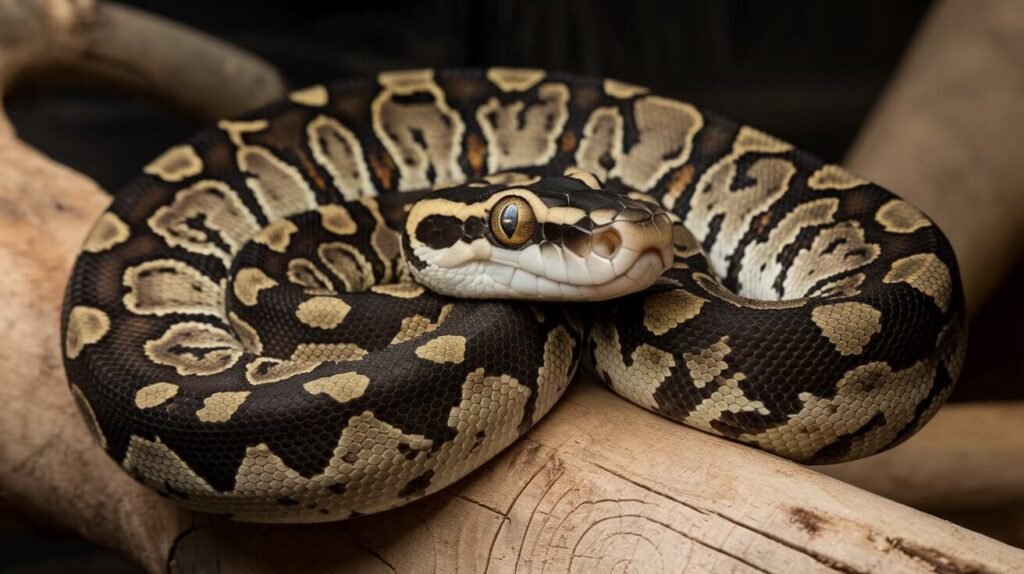
Table of Contents
- What Snakes Make Good Pets?: Why Choose a Snake as a Pet?
- What Snakes Make Good Pets?: Characteristics of Good Pet Snakes
- What Snakes Make Good Pets? Popular Choices
- What Snakes Make Good Pets? Tips for Choosing the Right Snake
- What Snakes Make Good Pets? Setting Up a Habitat for Your Pet Snake
- What Snakes Make Good Pets? Caring for Your Pet Snake
- Also Read: How Does Pet Grooming Relate to Agriculture?
- What Snakes Make Good Pets? Common Misconceptions About Pet Snakes
- What Snakes Make Good Pets? Challenges of Owning a Pet Snake
- How to Build a Positive Relationship with Your Pet Snake
- Common Health Issues in Pet Snakes and How to Address Them
- What Snakes Make Good Pets? Snakes to Avoid as Pets for Beginners
- Legal and Ethical Considerations for Owning a Pet Snake
- What is the friendliest snake to own?
- Are snakes friendly pets?
- What snakes like to be handled?
- Can snakes bond with humans?
- What Snakes Make Good Pets? The 10 Best Pet Snake Species
- How to Choose the Best Pet Snake for You
- Best Snake Pets for Beginners
- What snakes make good pets for kids?
- What snakes make good pets (as discussed)?
- What Snakes Make Good Pets? Pet Snakes That Don’t Bite
- What Snakes Make Good Pets? Best Pet Snakes for Kids
- What Snakes Make Good Pets? Pet Snakes That Stay Small
- Conclusion: What Snakes Make Good Pets?
- FAQs: What Snakes Make Good Pets?
- 1. What are the best types of snakes for beginners?
- 2. Do snakes like to be handled?
- 3. How often do pet snakes need to eat?
- 4. What do pet snakes eat?
- 5. How big do snakes get, and how much space do they need?
- 6. How do I create the right habitat for my pet snake?
- 7. Do snakes need special medical care?
- 8. How long do pet snakes live?
- 9. What are common behavioral issues in pet snakes?
- 10. Can I travel with my pet snake?
- 11. Are snakes dangerous as pets?
- 12. How do I find a reputable breeder or pet store for my snake?
- 13. What is the best way to handle my pet snake?
- 14. Can I keep more than one snake in the same enclosure?
- 15. Do I need to provide my snake with a water bowl?
What Snakes Make Good Pets?: Why Choose a Snake as a Pet?
1. Low Maintenance
Unlike dogs or cats, snakes don’t require daily walks, grooming, or attention. Their feeding schedules are less frequent, and they can thrive in a properly set up enclosure with minimal daily care.
2. Unique and Fascinating
Snakes come in a variety of colors, patterns, and sizes, offering a visual appeal unmatched by other pets. Their behaviors, such as shedding, feeding, and climbing, are captivating to observe.
3. Quiet Companions
Snakes are silent animals, making them ideal for owners who live in apartments or prefer a tranquil pet.
4. Educational Value
Keeping a snake can spark an interest in herpetology (the study of reptiles) and teach owners about ecosystems, biology, and environmental conservation.
What Snakes Make Good Pets?: Characteristics of Good Pet Snakes
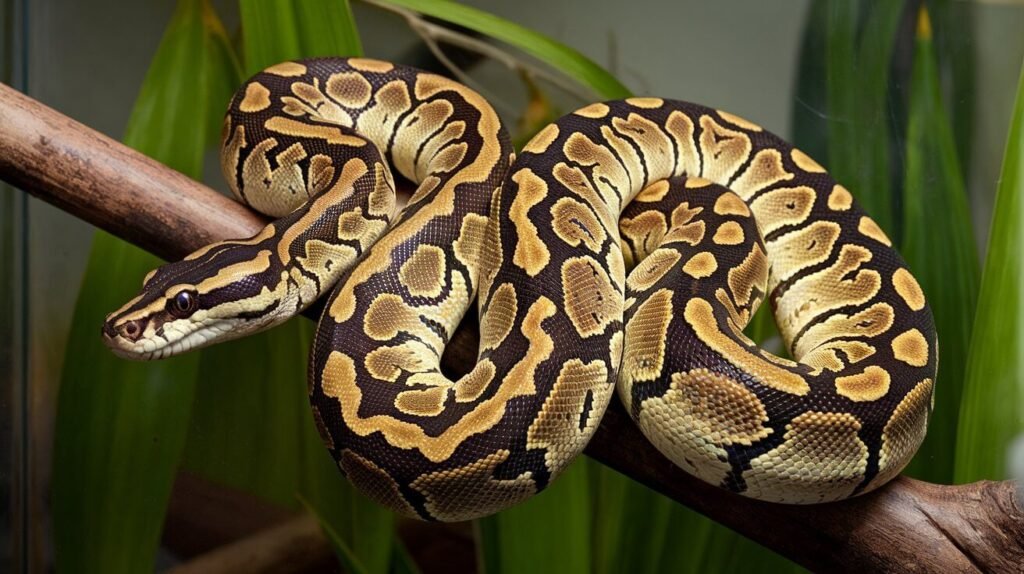
1. Docile Temperament
Snakes that are naturally calm and tolerate handling are best suited for beginners and families.
2. Manageable Size
Snakes that grow to a reasonable size—large enough to handle but small enough to fit in a typical enclosure—are easier to care for.
3. Simple Care Requirements
Species with straightforward diet and habitat needs are ideal, especially for beginners.
4. Longevity
Snakes are long-lived pets, with some species living 15–30 years in captivity. Owners should consider their commitment to caring for a pet over decades.
What Snakes Make Good Pets? Popular Choices
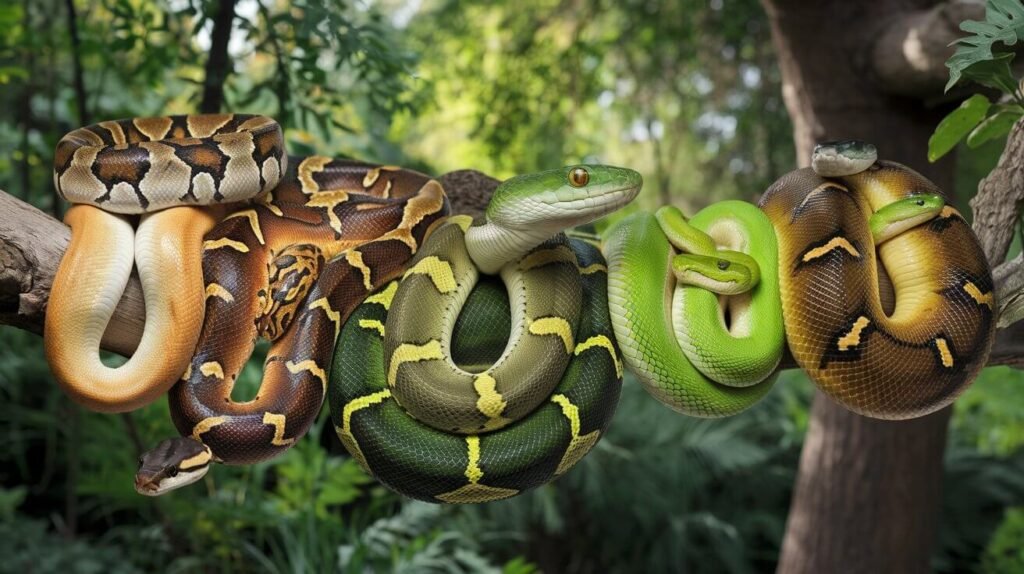
1. Corn Snakes
- Overview: One of the most popular pet snakes, corn snakes are known for their docile nature and vibrant colors.
- Size: Adults typically reach 3–5 feet.
- Care Needs:
- Simple diet of appropriately sized rodents.
- Enclosure should include hiding spots, climbing branches, and a temperature gradient.
- Require minimal maintenance and adapt well to handling.
- Why They’re Great: Easy to care for and handle, making them ideal for beginners.
2. Ball Pythons
- Overview: Ball pythons are gentle, shy snakes that curl into a ball when stressed or threatened.
- Size: Grow to about 4–5 feet long.
- Care Needs:
- Enclosure should mimic their natural habitat with a warm basking area and a cooler side.
- Diet consists of frozen-thawed or live rodents.
- Why They’re Great: Known for their calm demeanor and wide variety of morphs (color patterns).
3. King Snakes
- Overview: King snakes are active and hardy, known for their striking patterns and adaptability.
- Size: Typically 3–5 feet in length.
- Care Needs:
- Thrive in a secure enclosure with hiding spots.
- Diet includes rodents and occasional eggs.
- Why They’re Great: They are resilient, and their active nature makes them interesting to observe.
4. Milk Snakes
- Overview: Recognizable by their vibrant red, black, and white bands, milk snakes are non-venomous and easy to care for.
- Size: Grow to 2–5 feet, depending on the subspecies.
- Care Needs:
- Require a secure enclosure with appropriate humidity levels.
- Diet primarily consists of rodents.
- Why They’re Great: Their striking appearance and ease of care make them popular among reptile enthusiasts.
5. Garter Snakes
- Overview: Garter snakes are small, active snakes often found in the wild and kept as pets.
- Size: Typically 2–3 feet long.
- Care Needs:
- Thrive on a diet of small fish, amphibians, and occasionally rodents.
- Need a spacious enclosure with access to fresh water for soaking.
- Why They’re Great: They are small, active, and come in various natural colorations.
6. Rosy Boas
- Overview: Rosy boas are gentle, slow-moving snakes with a preference for burrowing.
- Size: Reach 2–4 feet in length.
- Care Needs:
- Require a dry environment with sandy substrate and hiding spots.
- Feed on small rodents every 1–2 weeks.
- Why They’re Great: Their docile nature and manageable size make them an excellent choice for beginners.
7. Hognose Snakes
- Overview: Hognose snakes are known for their upturned snouts and dramatic defensive displays.
- Size: Usually 1.5–3 feet long.
- Care Needs:
- Prefer a sandy or loamy substrate for burrowing.
- Diet includes small rodents and amphibians.
- Why They’re Great: Their unique appearance and playful behaviors are a delight to owners.
What Snakes Make Good Pets? Tips for Choosing the Right Snake
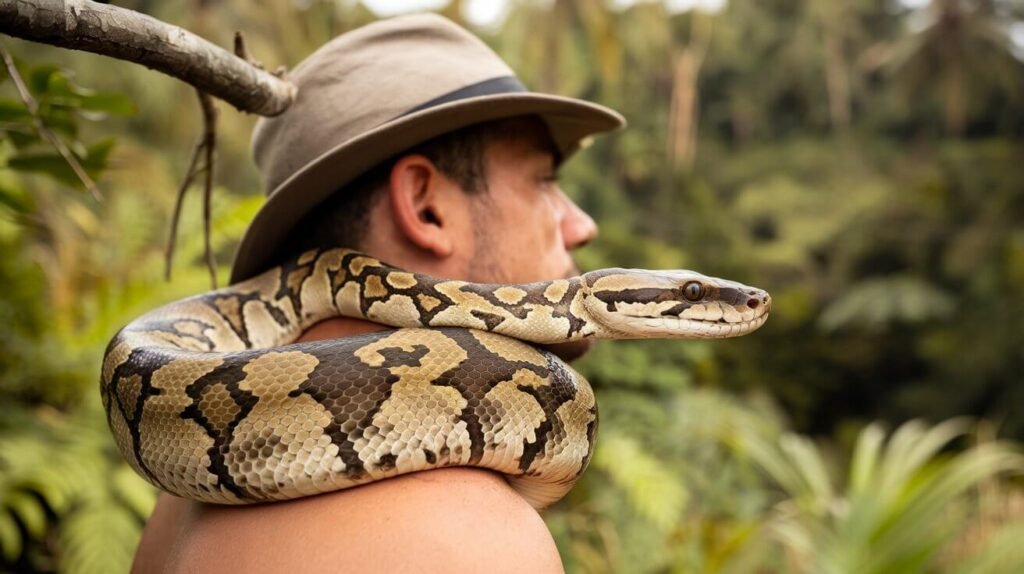
1. Consider Your Experience Level
- Beginners should opt for docile and low-maintenance species like corn snakes or ball pythons.
- Advanced keepers may explore more exotic or challenging species.
2. Research the Snake’s Needs
- Understand the habitat, diet, and care requirements of the species you’re interested in.
3. Check Legality
- Some snake species are restricted or require permits in certain regions.
4. Source Responsibly
- Purchase from reputable breeders or rescue organizations to ensure the snake is healthy and ethically sourced.
What Snakes Make Good Pets? Setting Up a Habitat for Your Pet Snake
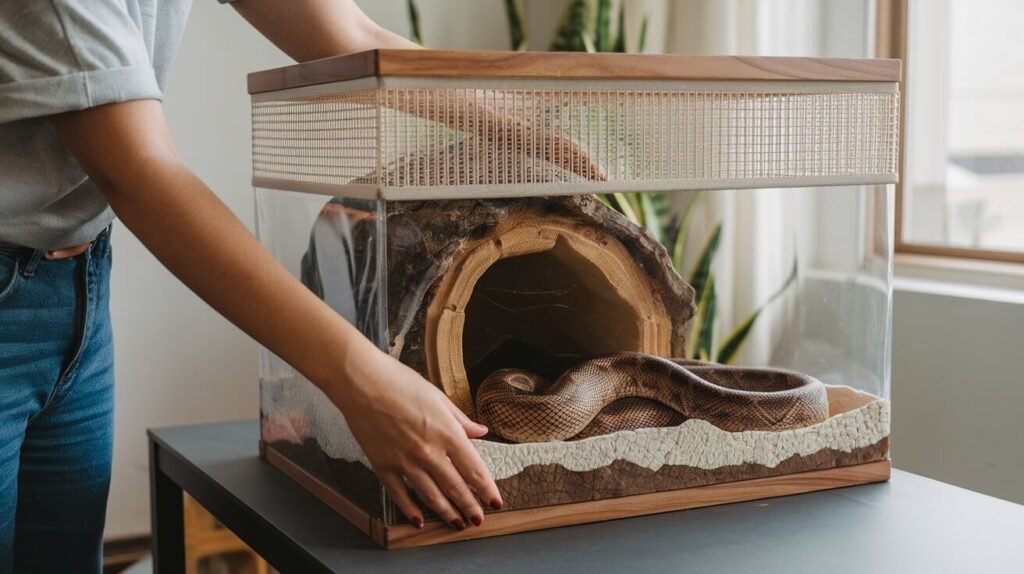
1. Enclosure
- Choose a secure, appropriately sized terrarium with a locking lid.
- Provide ample space for the snake to move, hide, and climb.
2. Temperature and Humidity
- Maintain a temperature gradient with a basking area and a cooler zone.
- Use thermometers and hygrometers to monitor conditions.
3. Substrate
- Select a substrate suited to the snake’s needs, such as aspen shavings, coconut fiber, or sand.
4. Accessories
- Include hiding spots, climbing branches, and water bowls for drinking and soaking.
5. Lighting
- While most snakes do not require UVB lighting, proper day-night cycles are essential.
What Snakes Make Good Pets? Caring for Your Pet Snake
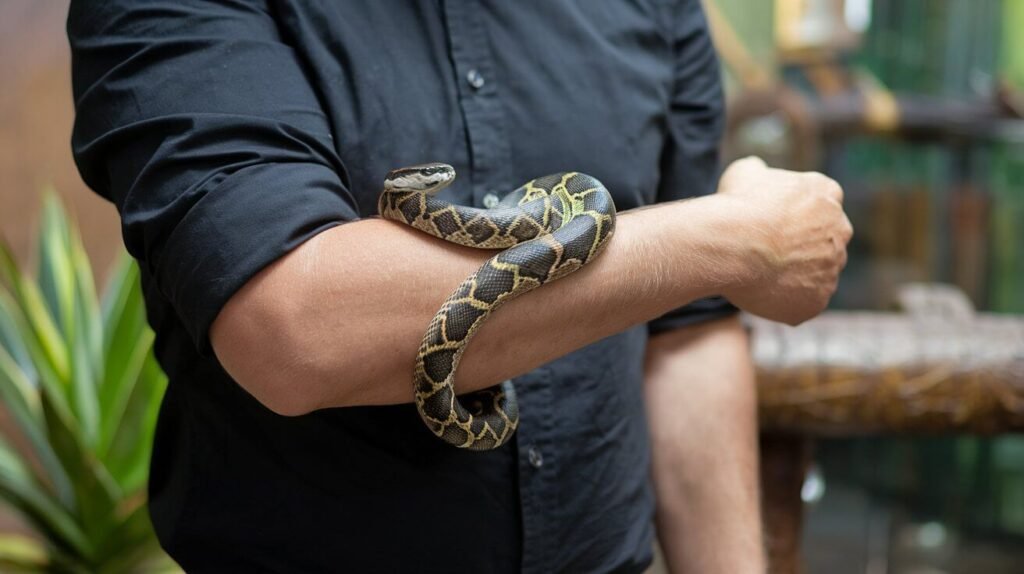
1. Feeding
- Feed pre-killed or frozen-thawed prey to minimize the risk of injury.
- Offer appropriately sized meals based on the snake’s size and age.
2. Cleaning
- Spot clean daily and perform a full enclosure cleaning monthly.
3. Handling
- Handle your snake gently and regularly to build trust and reduce stress.
4. Monitoring Health
- Watch for signs of illness, such as lethargy, loss of appetite, or difficulty shedding, and consult a veterinarian if needed.
Also Read: How Does Pet Grooming Relate to Agriculture?
What Snakes Make Good Pets? Common Misconceptions About Pet Snakes
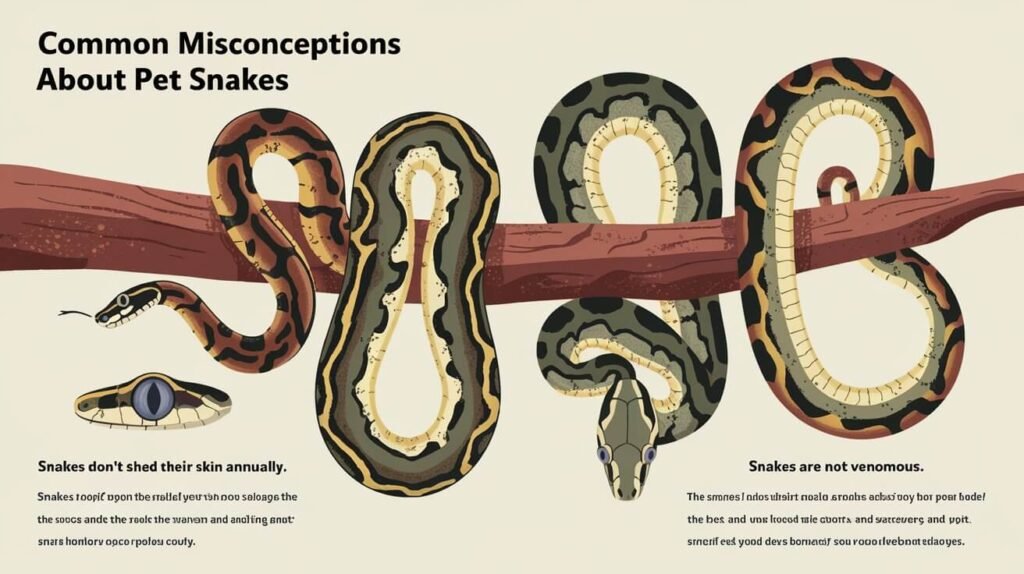
1. Snakes Are Dangerous
- Most pet-friendly snakes are non-venomous and unlikely to harm their owners.
2. Snakes Are Slippery and Slimy
- Snakes have smooth, dry scales that feel pleasant to the touch.
3. Snakes Require Constant Feeding
- Most snakes eat only once a week or less, depending on their size and age.
What Snakes Make Good Pets? Challenges of Owning a Pet Snake
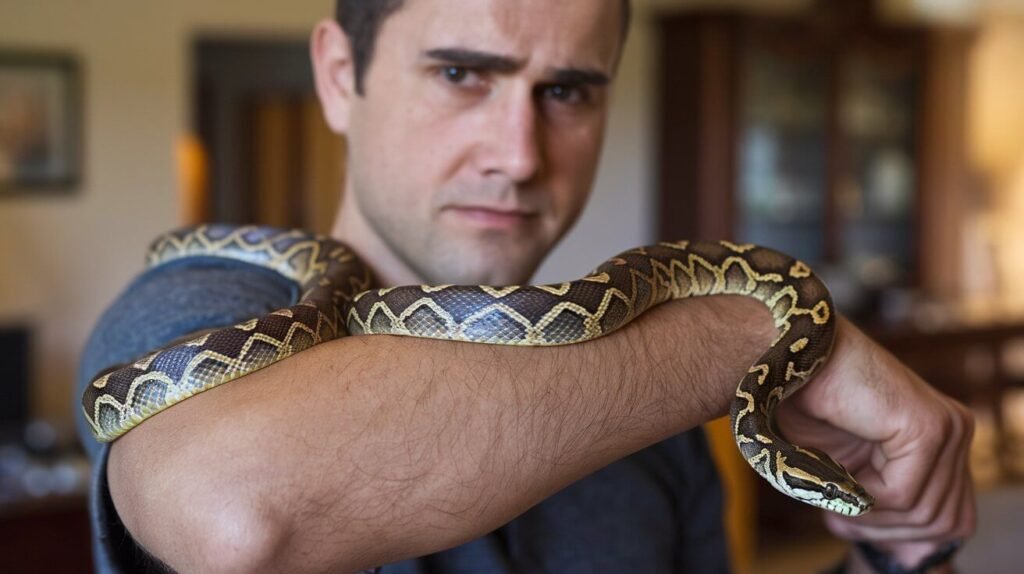
While snakes can be excellent pets, it’s important to consider potential challenges to ensure you are fully prepared for the responsibility.
1. Long-Term Commitment
- Longevity: Many pet snakes can live for 15–30 years, depending on the species. Owners need to be ready for a long-term commitment.
- Lifestyle Changes: Moving, job changes, or other life transitions may affect your ability to care for a snake properly.
2. Feeding Live Prey
- Ethical Concerns: Feeding live rodents to snakes can be distressing for some owners.
- Injuries to the Snake: Live prey can fight back, potentially injuring your snake. Many owners opt for frozen-thawed prey to avoid this issue.
3. Escaping the Enclosure
- Houdini-like Escapes: Snakes are natural escape artists. Owners must ensure enclosures are secure to prevent accidents or the snake’s disappearance.
4. Specialized Care Needs
- Temperature and Humidity Control: Maintaining the correct environment is crucial and may require specific equipment like heat lamps, under-tank heaters, or misting systems.
- Veterinary Care: Finding a veterinarian experienced in reptile care can be challenging, especially in remote areas.
5. Misunderstanding and Stigma
- Fear and Misconceptions: Friends, family, or landlords may react negatively to the idea of a pet snake.
- Restrictions: Some communities or rental agreements may prohibit reptile ownership.
How to Build a Positive Relationship with Your Pet Snake

Developing a bond with your pet snake may not be the same as with a dog or cat, but it is still possible to create a positive relationship.
1. Respect Their Nature
- Snakes are solitary animals by nature and do not seek companionship. Respect their need for alone time and avoid over-handling.
2. Handle Gently and Confidently
- Regular, gentle handling helps your snake become accustomed to you. Always support their body fully and avoid sudden movements.
3. Learn Their Behavior
- Understand signs of stress or discomfort, such as hissing, striking, or hiding excessively. Recognizing these cues will help you provide better care.
4. Provide Enrichment
- Enrichment items like climbing branches, tunnels, or varying substrate textures keep your snake mentally stimulated.
Common Health Issues in Pet Snakes and How to Address Them
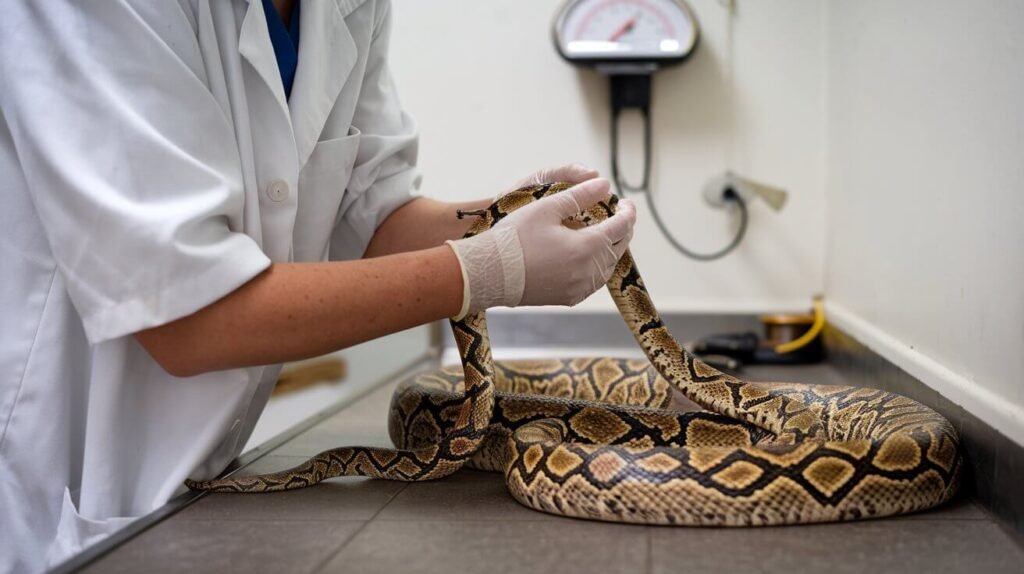
1. Shedding Problems (Dysecdysis)
- Cause: Often due to inadequate humidity.
- Solution: Increase enclosure humidity and provide a moist hide or soak your snake in warm water to assist shedding.
2. Respiratory Infections
- Cause: Poor ventilation, incorrect temperature, or high humidity levels.
- Symptoms: Wheezing, open-mouth breathing, or mucus around the nostrils.
- Solution: Adjust enclosure conditions and consult a veterinarian.
3. Parasites
- Cause: Contaminated substrate or prey items.
- Symptoms: Loss of appetite, lethargy, or visible mites.
- Solution: Clean the enclosure thoroughly and seek veterinary treatment.
4. Obesity
- Cause: Overfeeding or lack of activity.
- Solution: Monitor feeding schedules and ensure the snake has opportunities to climb or explore.
What Snakes Make Good Pets? Snakes to Avoid as Pets for Beginners

While some snakes make excellent pets, others can be too challenging for novice owners.
1. Large Constrictors (e.g., Burmese Pythons, Reticulated Pythons)
- These species can grow over 20 feet long and require massive enclosures and significant strength to handle.
2. Venomous Snakes (e.g., Cobras, Vipers)
- Venomous snakes are dangerous and require specialized training and permits in many areas.
3. Wild-Caught Snakes
- Wild-caught snakes may carry parasites, have difficulty adapting to captivity, and can be stressed or aggressive.
Legal and Ethical Considerations for Owning a Pet Snake

1. Check Local Laws
- Some states, provinces, or countries have strict regulations on owning snakes, especially exotic or large species.
2. Ethical Sourcing
- Avoid supporting the illegal wildlife trade. Purchase snakes from reputable breeders or adopt from rescue organizations.
3. Conservation Awareness
- Be aware of the role reptiles play in ecosystems and avoid species that are endangered or heavily trafficked.
What is the friendliest snake to own?
- Corn Snakes: Often considered one of the friendliest and most docile snakes, making them ideal for beginners.
- Ball Pythons: Known for their calm and non-aggressive temperament.
- Rosy Boas: Small, gentle, and easy to handle.
- California Kingsnakes: Usually friendly when properly handled, though they can be more active.
Are snakes friendly pets?
- Snakes do not experience emotions like humans, so they are not “friendly” in the traditional sense. However:
- Docility: Many pet snakes are calm and tolerate human interaction well.
- Behavior: Some snakes, like ball pythons or corn snakes, are known for being gentle and comfortable with handling.
- Bonding: While snakes don’t form emotional bonds, they can learn to recognize you as a non-threatening presence.
What snakes like to be handled?
- Corn Snakes: Enjoyable to handle due to their tolerance and calm demeanor.
- Ball Pythons: Slow-moving and comfortable with handling.
- Rosy Boas and Milk Snakes: Both species are generally good with handling after acclimation.
- Garter Snakes: Typically tolerate handling well when socialized.
Can snakes bond with humans?
- No Emotional Bond: Snakes lack the emotional capacity for bonding like mammals.
- Recognizing Owners: Over time, snakes can recognize their owner’s scent and routine, reducing stress during interactions.
- Trust-Based Relationship: Frequent and gentle handling can create a sense of trust or familiarity.
What Snakes Make Good Pets? The 10 Best Pet Snake Species
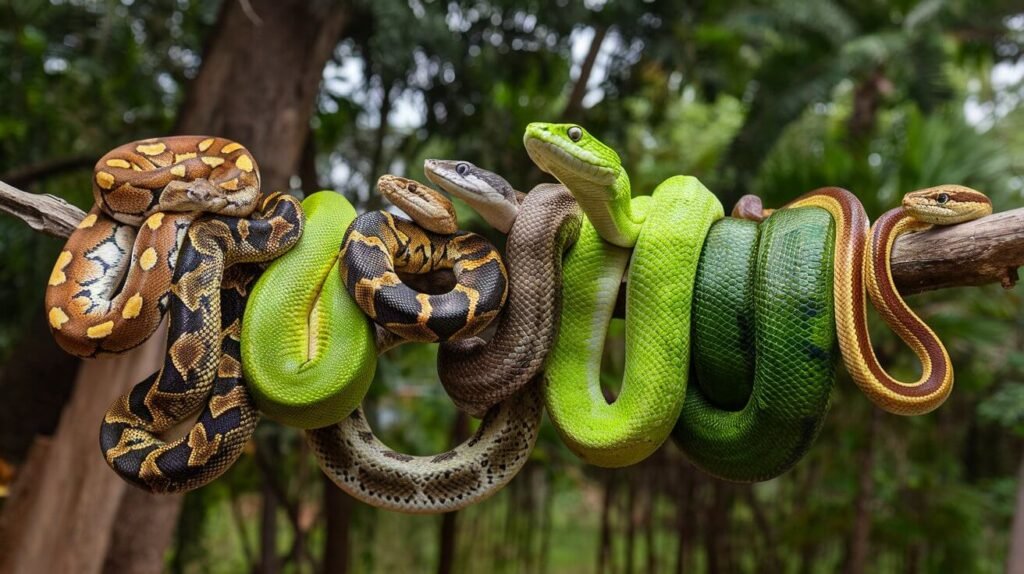
- Corn Snake
- Ball Python
- Rosy Boa
- California Kingsnake
- Garter Snake
- Milk Snake
- Western Hognose Snake
- Children’s Python
- Kenyan Sand Boa
- Smooth Green Snake
How to Choose the Best Pet Snake for You
- Experience Level: Beginners should stick to docile and low-maintenance species (e.g., corn snakes).
- Size Preference: Decide if you prefer smaller species (e.g., Kenyan sand boa) or larger snakes (e.g., ball python).
- Handling Needs: If you enjoy frequent interaction, choose a species tolerant of handling.
- Habitat and Care: Consider the space, temperature, and dietary requirements of the snake.
Best Snake Pets for Beginners
- Corn Snakes: Hardy, easy to care for, and adaptable to beginners.
- Ball Pythons: Low-maintenance and calm.
- Rosy Boas: Small and undemanding.
- Western Hognose Snakes: Unique appearance and manageable care needs.
What snakes make good pets for kids?
- Corn Snakes: Gentle and non-threatening.
- Ball Pythons: Known for being “slow movers” and safe.
- Milk Snakes: Colorful, small, and manageable for kids.
- Kenyan Sand Boas: Small size and docile nature make them a fun choice.
What snakes make good pets (as discussed)?
- Popular Recommendations:
- Corn Snakes and Ball Pythons: Frequently praised for their beginner-friendly nature.
- Garter Snakes and Western Hognose Snakes: Highlighted for their unique looks and ease of care.
- Personal Preferences: Many Reddit users stress researching each species’ specific needs.
What Snakes Make Good Pets? Pet Snakes That Don’t Bite
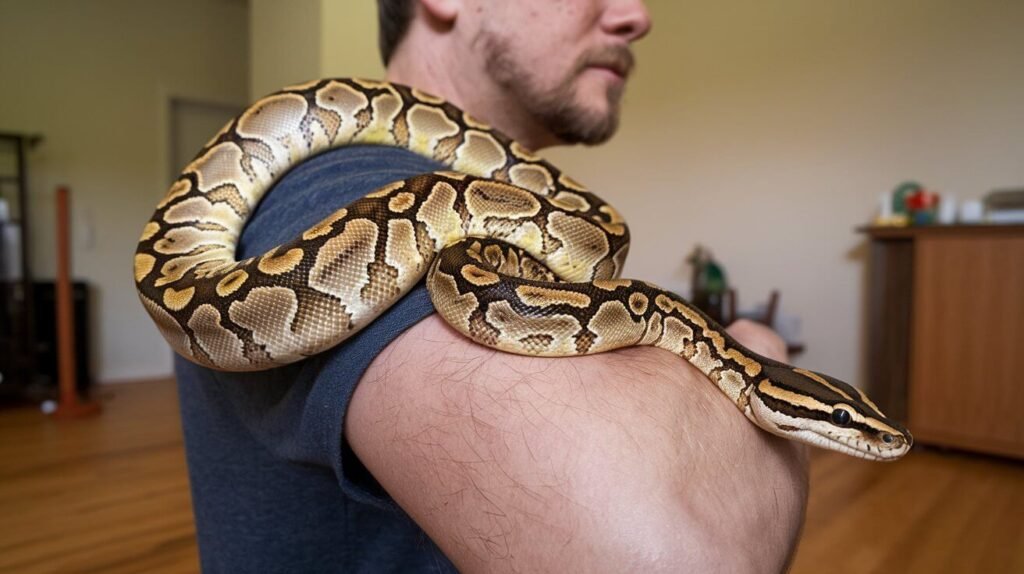
- Corn Snakes, Rosy Boas, Ball Pythons: Known for their calm temperaments and reluctance to bite.
- Hognose Snakes: Rarely bite but may display bluffing behaviors when scared.
- Garter Snakes: Gentle and easy-going.
Corn Snake
- Why Popular: Corn snakes are loved for their manageable size, vibrant colors, and gentle nature.
- Care: Easy to feed (mice) and maintain in a standard enclosure.
- Handling: Calm and tolerant of frequent interaction.
What Snakes Make Good Pets? Best Pet Snakes for Kids
- Corn Snakes and Ball Pythons: Ideal for their predictable and calm behavior.
- Milk Snakes: Attractive patterns, easy to handle.
- Kenyan Sand Boas: Minimal space and care needs.
What Snakes Make Good Pets? Pet Snakes That Stay Small
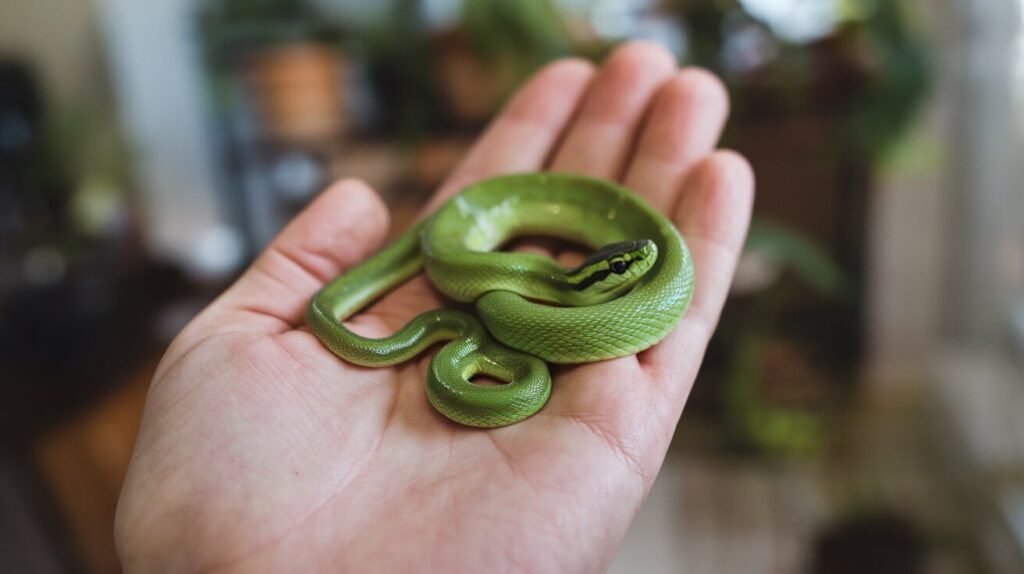
- Rosy Boas, Kenyan Sand Boas: Rarely grow beyond 2-3 feet.
- Children’s Pythons: Small and manageable.
- Western Hognose Snakes: Compact and lightweight.
Coolest Pet Snakes
- Western Hognose Snakes: Unique upturned snout.
- Green Tree Pythons: Striking green coloration (for more experienced owners).
- Milk Snakes: Vibrant red, black, and white bands.
- Rainbow Boas: Iridescent scales that reflect light beautifully.
Conclusion: What Snakes Make Good Pets?
Snakes make unique, rewarding, and low-maintenance pets for those who take the time to research their needs. Whether you choose a corn snake for its beginner-friendly care or a hognose snake for its playful personality, the key is understanding what makes a snake a good pet and providing the right environment.
Before bringing a snake into your home, consider your experience level, the time and resources you can dedicate to its care, and your long-term commitment. With the right preparation and mindset, owning a snake can be a fascinating and fulfilling experience that connects you to the natural world in a profound way.
FAQs: What Snakes Make Good Pets?
1. What are the best types of snakes for beginners?
Some of the best snakes for beginners include:
- Corn Snakes: Docile, small, and easy to care for.
- Ball Pythons: Calm temperament and manageable size.
- Garter Snakes: Small, active, and easy to handle.
- Rosy Boas: Gentle, slow-moving, and low-maintenance.
These species are known for their friendly nature and relatively simple care requirements
2. Do snakes like to be handled?
Snakes generally do not crave interaction like mammals, but many species enjoy being handled if done gently and correctly. Regular handling can help build trust, especially with snakes that have more docile temperaments, such as ball pythons or corn snakes. However, some snakes may become stressed from too much handling, so it’s important to watch for signs of distress like hissing or retreating into hiding.
3. How often do pet snakes need to eat?
Most pet snakes only need to eat once a week or even less frequently, depending on their size and age. For example:
- Young snakes may eat more frequently, such as once every 5–7 days.
- Adult snakes may eat every 10–14 days.
The type and size of prey also influence feeding frequency. It’s important to feed snakes an appropriate-sized meal to ensure they maintain a healthy weight and metabolism.
4. What do pet snakes eat?
Most pet snakes are carnivores and feed primarily on rodents such as mice or rats. Some species, like garter snakes, may also consume amphibians, fish, or eggs. Snakes generally eat pre-killed or frozen-thawed prey to prevent injury from live animals.
5. How big do snakes get, and how much space do they need?
The size of your pet snake depends on the species:
- Small snakes like corn snakes or king snakes grow to around 3–4 feet.
- Larger snakes such as ball pythons can reach 5 feet, and constrictors like Burmese pythons can exceed 20 feet.
In general, snakes should be housed in an appropriately sized enclosure. Smaller snakes may need a 20–40 gallon tank, while larger species may require a 75-gallon tank or even larger enclosures. Proper space allows them to move, explore, and feel secure.
6. How do I create the right habitat for my pet snake?
Creating an appropriate habitat for your snake involves:
- Temperature Control: Most snakes require a temperature gradient, with one side of the tank being warmer for basking (around 85–90°F) and the other cooler for resting (around 70–75°F).
- Humidity: The required humidity level varies by species, but generally, a humidity range of 40–60% is ideal for most pet snakes.
- Hiding Spots: Provide at least one hiding spot where the snake can retreat to feel secure.
- Substrate: Use substrates such as aspen shavings, coconut fiber, or paper towels, depending on the species’ needs.
- Lighting: While most snakes don’t need UVB light, it’s important to maintain a natural day-night cycle with proper lighting.
7. Do snakes need special medical care?
Yes, like any pet, snakes require regular health monitoring. If your snake shows signs of illness, such as lethargy, loss of appetite, or abnormal behavior, it’s important to consult a reptile veterinarian. Common health issues in snakes include respiratory infections, shedding problems, and parasites. Routine check-ups can help ensure your snake stays healthy and free of common ailments.
8. How long do pet snakes live?
years. For example:
- Corn snakes may live 15–20 years.
- Ball pythons can live up to 30 years or more in captivity.
- Garter snakes typically live 5–10 years.
Long lifespan means a long-term commitment to c
9. What are common behavioral issues in pet snakes?
Some common behavioral issues in pet snakes include:
- Refusing food: This can be due to stress, illness, improper temperature, or incorrect prey size.
- Excessive hiding: While some snakes naturally hide a lot, if this behavior is new or accompanied by signs of illness, it may indicate stress or health issues.
- Aggression: Some snakes may exhibit defensive behavior, such as hissing, striking, or biting, especially when they are not used to handling. Being patient and gentle can help alleviate this.
Understanding your snake’s behavior and making adjustments to its habitat or routine can help resolve these issues.
10. Can I travel with my pet snake?
Yes, you can travel with your pet snake, but it requires careful planning. Ensure the snake’s enclosure is secure, maintain appropriate temperatures during travel, and bring food for the journey. You may need to adjust your pet’s feeding schedule and handling routine while on the road. Long trips can be stressful for snakes, so always ensure they have a stable environment during travel.
11. Are snakes dangerous as pets?
Most snakes kept as pets are non-venomous and are not dangerous to humans. Common pet species, like ball pythons and corn snakes, are known for their calm and docile nature. However, it is important to handle all snakes with care and respect, especially larger species or more defensive ones. Avoid feeding live prey to prevent injury to your snake, and ensure that enclosures are secure to prevent escapes.
12. How do I find a reputable breeder or pet store for my snake?
To find a reputable breeder or pet store:
- Check for certifications: Look for breeders who are certified by reputable organizations, such as the Association of Reptile and Amphibian Veterinarians (ARAV).
- Ask for references: Good breeders will be happy to provide references or reviews from previous customers.
- Inspect the conditions: Visit the facility to ensure snakes are kept in clean, appropriate conditions.
- Research before buying: Learn as much as you can about the specific species to ensure the breeder or store can provide the appropriate care advice.
13. What is the best way to handle my pet snake?
When handling your pet snake, keep the following tips in mind:
- Be gentle: Always support the snake’s body with both hands to avoid causing stress or injury.
- Avoid sudden movements: Quick movements can startle or stress the snake.
- Respect their boundaries: Don’t handle your snake immediately after it has eaten or when it is shedding, as these are times when snakes are more sensitive.
- Don’t pick them up by the head or tail: Always hold the snake’s midsection, as grabbing the tail or head can make them feel threatened.
14. Can I keep more than one snake in the same enclosure?
It’s generally not recommended to keep more than one snake in the same enclosure, especially with different species. Snakes are solitary animals, and some may exhibit territorial or aggressive behavior toward others. If you want to keep multiple snakes, they should be of the same species, gender (males are typically safer together), and similar size to minimize stress and potential harm.
15. Do I need to provide my snake with a water bowl?
Yes, snakes need access to clean water at all times. A shallow water bowl is essential for hydration and can also serve as a soaking area for some species. The size of the water bowl should allow your snake to fully submerge if it wants to soak, especially for species that enjoy bathing or for those going through a shedding cycle.







